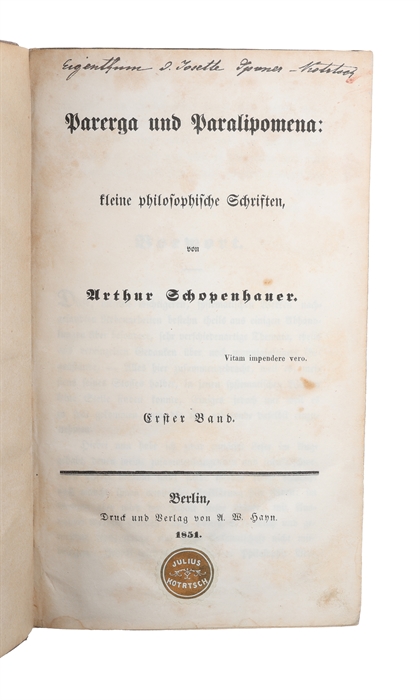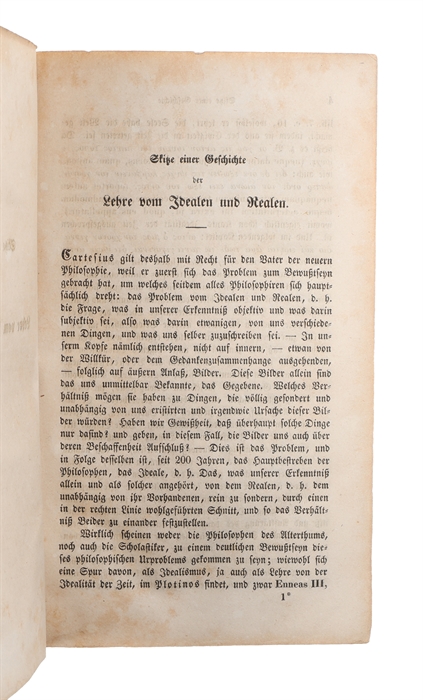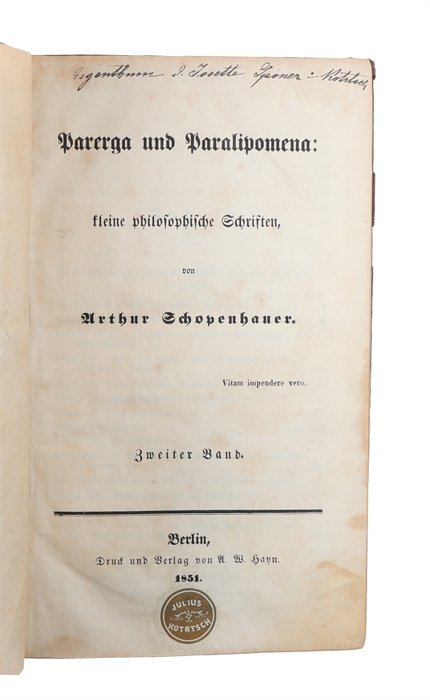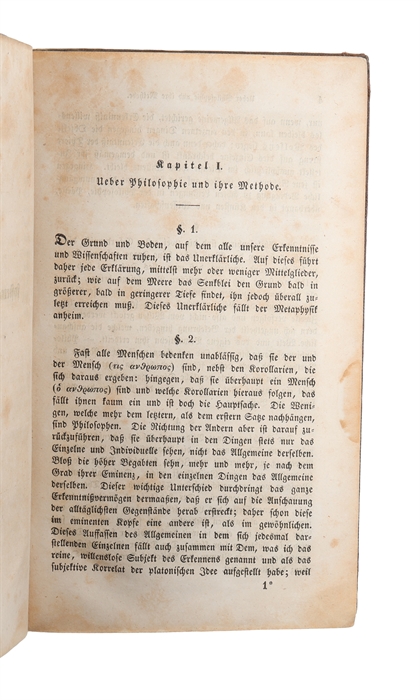SCHOPENHAUER'S MOST INFLUENTIAL WORK, HIS FINAL MASTERPIECE THAT CATAPULTED HIM INTO FAME
SCHOPENHAUER, ARTHUR.
Parerga und Paralipomena. 2 vols.
Berlin, Hayn, 1851.
8vo. Uniformly bound in two uniform, contemporary - possibly original! - embossed full cloth bindings. Embossed lettering and ornamentation to spine. Spines and borders of boards slightly faded. Spines with repairs. Front free end-paper in vol. 2 with repair. Previous owner's label (Julius Kotrtsch) pasted on to lower margin of title-pages. Previous owner's name in contemporary hand to upper margin of title-pages. Verso of last leaf in vol. 2 annotated in pencil. Vol. 1 with light occasinal marginal browspotting. (6), 465, (1) pp.; IV, 531 pp.
The scarce first edition of Schopenhauer's most influential work, his final masterpiece, which consists in his seminal philosophical reflections. The Parerga and Paralipomena was the first of his works to gain recognition and the work that propelled the then obscure figure into lasting philosophical prominence. Seeing that all of Schopenhauer's previous publications had been complete failures, it was only with great difficulty and reluctance that Hayn of Berlin was pesuaded to print the work, which they then only did in a small printrun of merely 750 copies, which now makes the first edition very difficult to find. The work is is two parts with the first "parerga"-part consisting in six extended essays intended as supplementary to the author's thought whereas the second "paralipomena"-part consists in shorter elaborations divided by topic into thirty-one subheadings that cover material hitherto unaddressed by Schopenhauer, but complementary to the "parerga". In spite of the poor reception of his earlier works, somehow, the “Parerga and Paralipomena attracted the attention of John Oxenford, a noted observer and translator of German literary culture, who contributed a favourable review of the work in 1852 and in 1853 wrote an article on Schopenhauer's philosophy entitled "Iconoclasm in German Philosophy", which, through its German translation in Vossische Zeitung sparked in immediate interest of Schopenhauer's work in Germany and propelled him into philosophical fame. “The effect was dramatic and almost overnight Schopenhauer in his own country passed from obscurity to fame and from then till his death in 1860he basked in the sunshine of belated recognition and eminence.” (Payne, in the Preface to his translation of Parerga and Paralipomena into English, Oxford, 2000p. xii) The work greatly influenced later philosophers, most notably Nietzsche, whose fondness of aphorism is directly inspired by “Parerga and Paralipomena”. “One of the most significant and fascinating works of the great philosopher Arthur Schopenhauer (1788-1860). The Parerga (Volume 1) are six long essays; the Paralipomena (Volume 2) are shorter writings arranged under thirty-one different subject-headings. These works won widespread attention with their publication in 1851, helping to secure lasting international fame for Schopenhauer. Indeed, their intellectual vigor, literary power, and rich diversity are still extraordinary even today.” (Payne).
Order-nr.: 62019





